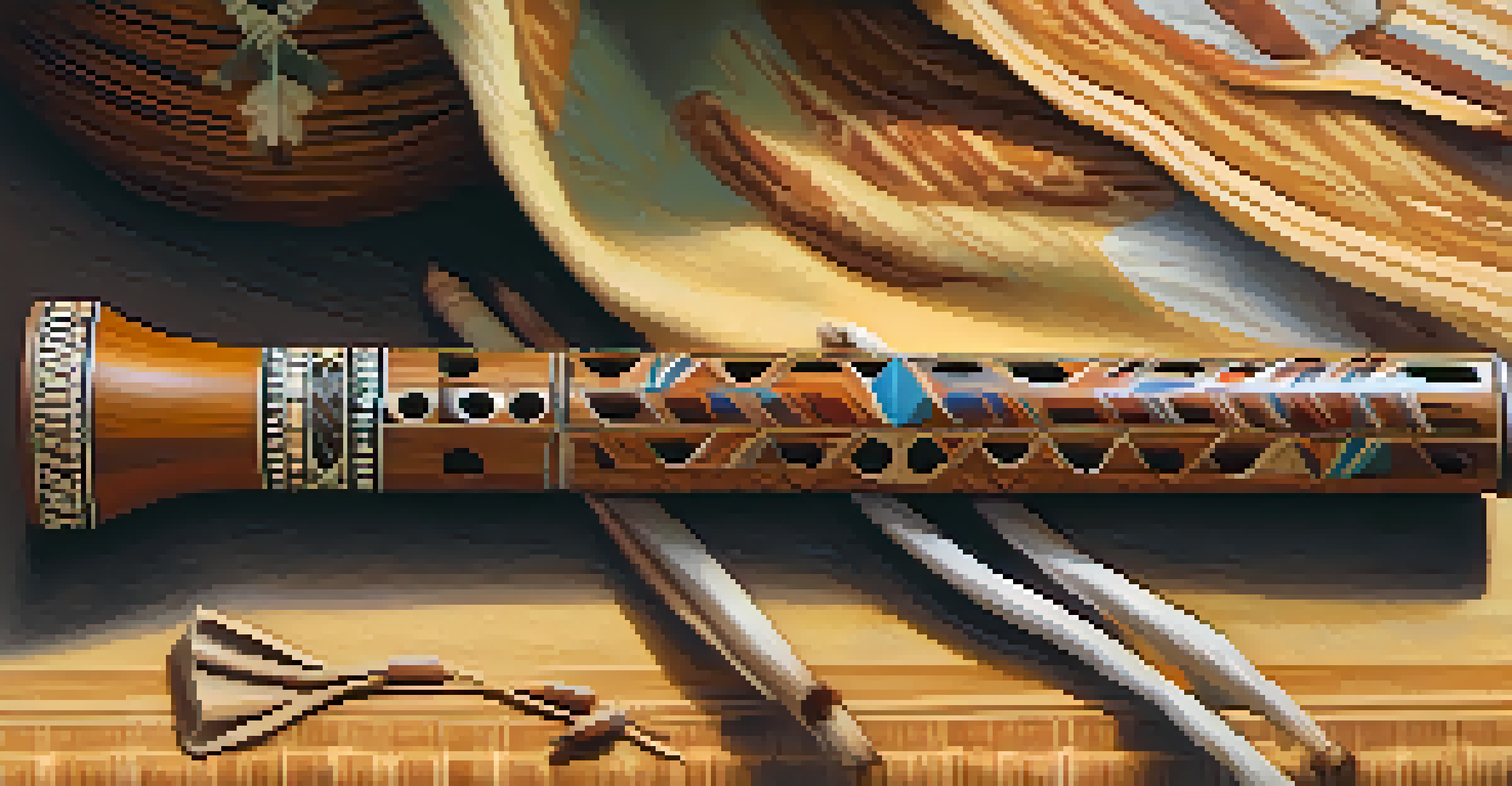Exploring the Roots of Native American Music in Arizona

Understanding Native American Music's Significance
Native American music is more than just a collection of sounds; it serves as a cultural backbone for many communities. It encapsulates stories, traditions, and spiritual beliefs, making it an essential part of daily life and ceremonies. In Arizona, this music often reflects the unique landscapes and history of the tribes that inhabit the region.
Music is the shorthand of emotion.
For instance, the Navajo people incorporate music in rituals that celebrate life events, from births to healing ceremonies. These songs are not only performed but are deeply felt, connecting the community to their ancestors and the natural world. This importance is echoed in the music's rhythms, melodies, and instruments, which are often crafted from local materials.
Moreover, music acts as a bridge between generations, allowing younger members to learn about their heritage. By participating in traditional music-making, youth gain a sense of identity and belonging, fostering respect for their cultural practices.
Instruments: Echoes of Tradition and Nature
The instruments used in Native American music are as diverse as the tribes themselves. Common instruments include drums, flutes, and rattles, each with its own significance and sound. The traditional hand drum, for example, is often used in various ceremonies and symbolizes the heartbeat of Mother Earth.

Flutes, particularly those made from wood or clay, are integral to many Southwestern tribes. They produce haunting melodies that often accompany storytelling, helping to transport listeners to another time and place. The craftsmanship of these instruments reflects the deep connection between the maker and the materials found in their environment.
Cultural Backbone of Native Music
Native American music serves as a vital expression of cultural identity, storytelling, and spiritual beliefs within communities.
In addition to traditional instruments, contemporary Native American musicians often blend modern sounds with traditional elements. This fusion not only honors their roots but also engages wider audiences, demonstrating the evolving nature of their musical heritage.
The Role of Storytelling in Native Music
Storytelling is a fundamental aspect of Native American culture, and music plays a vital role in conveying these narratives. Songs often tell tales of creation, heroism, and the natural world, serving as both entertainment and education. In Arizona, many songs reflect the history of the land and its peoples, preserving memories that might otherwise fade.
The language of music is universal; it speaks to the heart of humanity.
For example, the Hopi people use music to recount the tales of their ancestors and the lessons learned from their experiences. These stories, woven into melodic patterns, create a rich tapestry of cultural identity. This practice ensures that younger generations remain connected to their heritage and understand their place in the world.
Furthermore, music functions as a means of resistance and resilience. In times of struggle, songs can uplift spirits and unify communities, reminding them of their strength and shared history.
Ceremonial Uses of Music in Native American Culture
Ceremonies are vital to Native American life, and music is often at the heart of these events. Whether it's a wedding, a harvest celebration, or a healing ritual, music sets the tone and creates a sacred space. In Arizona, the variety of ceremonies showcases the rich diversity of practices among different tribes.
During ceremonies, songs are performed to invoke the presence of ancestors or spirits, seeking guidance and blessings. The rhythms and lyrics are carefully chosen to resonate with the occasion, making each performance unique. For instance, the Pawnee tribe has specific songs for planting, which connect their agricultural practices to their spirituality.
Instruments Reflect Heritage and Nature
The diverse instruments used in Native American music symbolize the connection between tribes, their traditions, and the natural world.
Moreover, these ceremonies foster community bonds, bringing people together to celebrate and remember their shared history. The collective experience of music strengthens relationships and reinforces cultural ties, making it an indispensable part of tribal life.
Modern Influences on Native American Music
While rooted in tradition, Native American music has embraced modern influences, creating a dynamic and evolving soundscape. Contemporary artists often blend traditional elements with genres like rock, jazz, and hip-hop, reaching new audiences and keeping their heritage alive. This fusion not only showcases their creativity but also challenges stereotypes.
For example, musicians like R. Carlos Nakai have gained international acclaim by combining traditional flute playing with contemporary styles. His work illustrates how Native American music can adapt while still honoring its roots. These artists are not just musicians; they are cultural ambassadors, sharing the richness of their heritage with the world.
Additionally, platforms like social media and streaming services allow Native American musicians to share their work globally. This exposure helps to educate listeners about their culture, fostering appreciation and respect for their artistry.
The Influence of Native American Music on Popular Culture
Native American music has significantly influenced popular culture, inspiring countless artists across various genres. From classic rock to film scores, elements of this rich musical tradition can be heard in unexpected places. This cross-pollination not only highlights the beauty of Native American music but also underscores its relevance in contemporary society.
Movies, in particular, have played a crucial role in introducing Native American music to wider audiences. Soundtracks often incorporate traditional instruments and melodies, creating an authentic atmosphere that enhances storytelling. This exposure can spark interest in Native cultures and encourage further exploration of their music and traditions.
Modern Fusion Keeps Tradition Alive
Contemporary Native American musicians blend traditional sounds with modern styles to engage new audiences while honoring their heritage.
However, it's essential to approach this influence respectfully. Misrepresentation can lead to cultural appropriation, where the essence of the music is lost. Therefore, understanding the roots of these sounds and giving credit to their origins is vital for fostering genuine appreciation.
Preserving Native American Music for Future Generations
As with many cultural practices, preserving Native American music is crucial for maintaining identity and heritage. Many tribes are actively working to document their musical traditions, ensuring they are passed down to future generations. This effort includes recording traditional songs and teaching younger members how to play instruments.
Community workshops and music festivals play a significant role in this preservation. They provide platforms for sharing knowledge and skills while celebrating the richness of Native American music. Participants not only learn about the music but also the stories and history that accompany each song.

Furthermore, collaborations between traditional musicians and contemporary artists can create new opportunities for preservation and innovation. By blending the old with the new, they can keep the music vibrant and relevant, ensuring its survival in an ever-changing world.